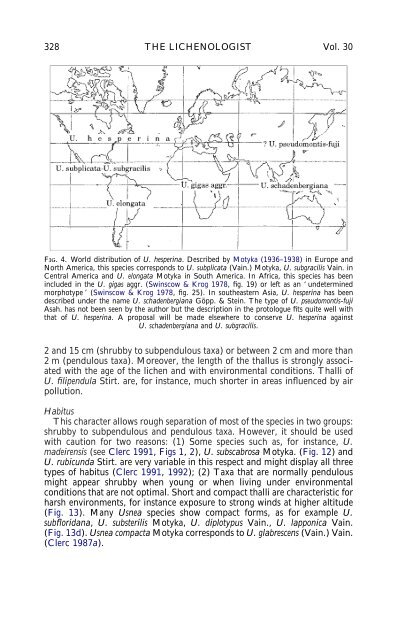SPECIES CONCEPTS IN THE GENUS USNEA (LICHENIZED ...
SPECIES CONCEPTS IN THE GENUS USNEA (LICHENIZED ...
SPECIES CONCEPTS IN THE GENUS USNEA (LICHENIZED ...
You also want an ePaper? Increase the reach of your titles
YUMPU automatically turns print PDFs into web optimized ePapers that Google loves.
328 <strong>THE</strong> LICHENOLOGIST Vol. 30<br />
Fig. 4. World distribution of U. hesperina. Described by Motyka (1936–1938) in Europe and<br />
North America, this species corresponds to U. subplicata (Vain.) Motyka, U. subgracilis Vain. in<br />
Central America and U. elongata Motyka in South America. In Africa, this species has been<br />
included in the U. gigas aggr. (Swinscow & Krog 1978, fig. 19) or left as an ‘ undetermined<br />
morphotype ’ (Swinscow & Krog 1978, fig. 25). In southeastern Asia, U. hesperina has been<br />
described under the name U. schadenbergiana Göpp. & Stein. The type of U. pseudomontis-fuji<br />
Asah. has not been seen by the author but the description in the protologue fits quite well with<br />
that of U. hesperina. A proposal will be made elsewhere to conserve U. hesperina against<br />
U. schadenbergiana and U. subgracilis.<br />
2 and 15 cm (shrubby to subpendulous taxa) or between 2 cm and more than<br />
2 m (pendulous taxa). Moreover, the length of the thallus is strongly associated<br />
with the age of the lichen and with environmental conditions. Thalli of<br />
U. filipendula Stirt. are, for instance, much shorter in areas influenced by air<br />
pollution.<br />
Habitus<br />
This character allows rough separation of most of the species in two groups:<br />
shrubby to subpendulous and pendulous taxa. However, it should be used<br />
with caution for two reasons: (1) Some species such as, for instance, U.<br />
madeirensis (see Clerc 1991, Figs 1, 2), U. subscabrosa Motyka. (Fig. 12) and<br />
U. rubicunda Stirt. are very variable in this respect and might display all three<br />
types of habitus (Clerc 1991, 1992); (2) Taxa that are normally pendulous<br />
might appear shrubby when young or when living under environmental<br />
conditions that are not optimal. Short and compact thalli are characteristic for<br />
harsh environments, for instance exposure to strong winds at higher altitude<br />
(Fig. 13). Many Usnea species show compact forms, as for example U.<br />
subfloridana, U. substerilis Motyka, U. diplotypus Vain., U. lapponica Vain.<br />
(Fig. 13d). Usnea compacta Motyka corresponds to U. glabrescens (Vain.) Vain.<br />
(Clerc 1987a).

















